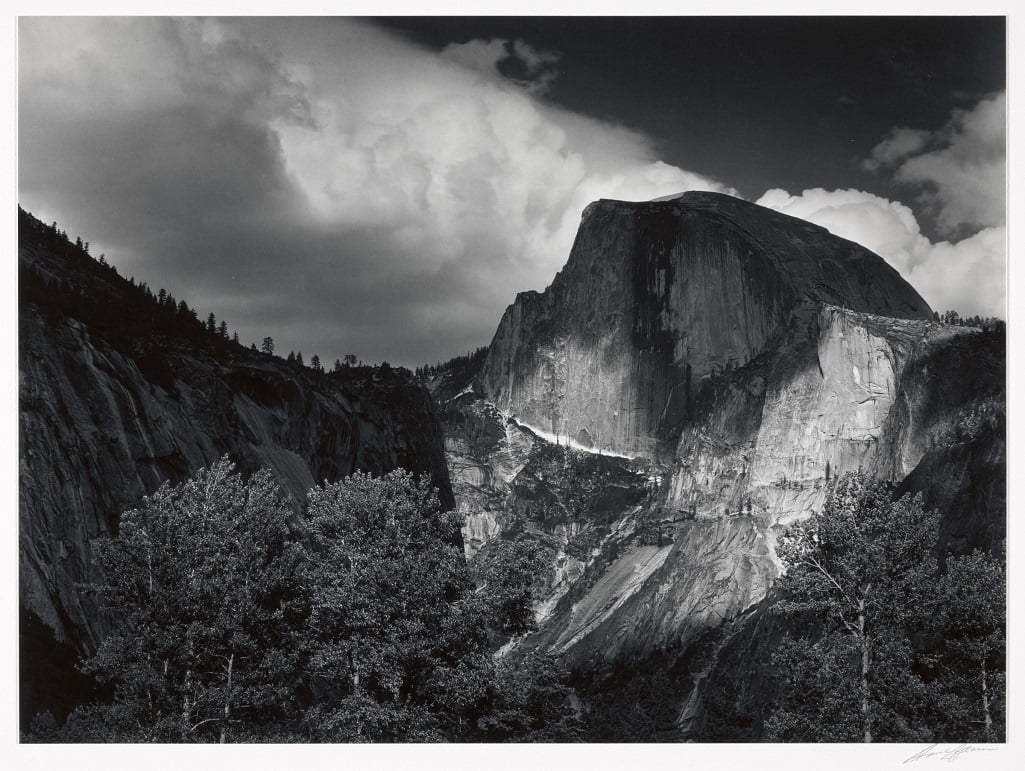Pioneering American photographer Ansel Adams may be remembered today mainly for his prints on waiting room walls, but his work was crucial not just in establishing the way landscapes are photographed but in aiding conservation efforts across the USA. See a career-spanning exhibition of his work this month at VMFA.
Ansel Adams: you may know him from your coffee mug, the calendar in your cubicle, or the motivational print that once adorned the office wall of your school principal or dentist. No landscape photographer is as emblematic to the genre as Ansel Adams. His work encapsulates the chaos and majesty of the natural world. His life, which spanned most of the 20th century and took him through most of this country, was a dedication to pioneering photography and wildlife conservation.
“Ansel Adams: Compositions in Nature,” a 70-photograph exhibit featuring many selected and printed by Adams himself, is a new exhibit at the Virginia Museum of Fine Arts that surveys the work and motivations of the prolific photographer.
“[Adams] is not just this photographer of the grand vistas that may end up on a mug or a calendar,” said Dr. Christopher Oliver, curator for the show. “He’s an amazingly precise technical photographer who’s interested in what I often call ‘really concentrated hard-looking’… A lot of photography is just that.”
The exhibit explores three main occupations of Adams’s life: technical photographer, musician, and landscape conservationist.
“The perception of the American West, in particular, is shaped through the work of Ansel Adams,” Oliver said. “There are few artists whose name and works represent the extraordinary level of universal recognition and artistic achievement as that of Ansel Adams.”

1984), gelatin silver print, printed 1973–1975. Virginia Museum of Fine Arts, Adolph D. and
Wilkins C. Williams Fund, 75.29.2. Photograph by Ansel Adams © The Ansel Adams Publishing
Rights Trust.
Ansel Adams is “revered as one of the greatest photographers of our time,” said Alex Nyerges, director and CEO of the VMFA, during a media preview of the exhibit.
Born in 1902, Adams grew up near San Francisco, California. His family took regular trips to Yosemite National Park, where he took his first photographs with a Kodak Brownie camera. Fixated on becoming a pianist, the young Adams saw photography as little more than a hobby.
Adams spent his youth as the photographer for the Sierra Club. He regularly published photographs and writings in their bulletin, tended to their lodges, and eventually sat on their board of directors.
His work quickly made an impact on the public, which fueled an interest in protecting these lands. The exhibit features a demonstrative series from this time in Adams’s life; his first portfolio, Parmelian Prints of the High Sierras, is a compilation of his best work from this period.
“His prints especially in the postwar period, in the late ’40s and ’50s, became so much about celebrating the American landscape that they appeared in fine art museums and in very popular books,” Oliver said. “We’re now several generations deep of people thinking of Yosemite through the lens of Ansel, in so many ways.”
Placards throughout the exhibit explained that from a young age onward, Adams was primarily motivated by his love for the wilderness. Everything he did in his career was in some meditation or reflection on retaining our ecosystems.
“It is horrifying that we have to fight our own government to save the environment,” Adams once said.
The exhibition features 47 of Adam’s “museum set,” those he dubbed as his favorite works, which the museum rented from the Turtle Bay Foundation. And while the exhibit features some of Adams’ portrait and lifestyle photography, the exhibit’s main focus is around his work as a conservationist. Adams believed the camera to be the best medium at the time to influence government officials and sway the public.

1960. Virginia Museum of Fine Arts, Gift of Dr. and Mrs. Bernard J. Sabaroff, 85.1538. Photograph by
Ansel Adams © The Ansel Adams Publishing Rights Trust.
On the coattails of his prior portfolio, Adams traveled the country for the likes of not instagram but magazines and the U.S. government, photographing many national parks.
From misty moraines along the Tetons and the greening gorges of Yosemite to the pits of Death Valley, Adams lassoed the “elusive quality of nature” into every frame. He captured breathtaking scenes of wild Alaska, the Big Sur coast of central California, the mighty redwoods, the moonrise over Hernandez, New Mexico, and the Half Dome. He even photographed the Golden Gate — before the bridge.
He wielded his camera like a lance, dueling developers over the symptoms of “resortism,” such as encroaching highways, overbuilt billboards, privatized park services, and concessions by the U.S. government to private enterprise.
And today, many argue, much of America’s wilderness and the protections that still stand remain as a result of Adams and his camera.
In 1936, the Sierra Club sent Adams to Washington, D.C., to lobby for a bill before Congress that would create the Kings Canyon National Park. He lugged his portfolios from the Senate to House, meeting with more than 40 members of Congress, telling his story and sharing his photographs. While the bill failed, Adams did not. His photographs were sent to President Franklin D. Roosevelt, who established the park the following year, putting half a million acres into wildlife protection.
“Most people have the idea that there is nothing you can do with a camera in Yosemite except take another postcard snapshot,” Adams said shortly after. “I remind workshop participants that the national parks provide an experience, a mood, an incredible subject for the camera.”
Adams often compared photography to orchestra. He overlooked the ensemble of mountaintops, dunes, and forests, and thought of symphonies. The chaos of nature, he found, had a rhythm.
“I can look at a fine photograph and sometimes I can hear music, not in a sentimental sense, but structurally,” Adams once said.
Visitors to “Compositions In Nature” will hear some of Adams’s own musical recordings — Beethoven’s “Moonlight” Sonata, Johann Sebastian Bach’s “Arioso,” and Alexander Scriabin’s “Prelude” — as they walk through the exhibit.

gelatin silver print, printed 1974. Virginia Museum of Fine Arts, Gift of Andrea Gray Stillman,
2018.584. Photograph by Ansel Adams © The Ansel Adams Publishing Rights Trust.
Likewise, Adams carried his musical understanding into his photographic work, where he strove for a sharper focus, deeper tone, and more contrast. As his career progressed, Adams reveled in the theory and practice of the camera. He coined many of the systems digital photographers today take for granted, such as the zone system, a theory used to properly expose photos in nearly any situation.
He produced ten volumes of technical manuals on photography, including The Camera and Basic Techniques of Photography, which are the most influential books ever written on the subject. Within his lifetime he played a key role in establishing the first museum department of photography, at the Museum of Modern Art in New York City.
“In a career that spanned more than five decades, Adams became one of America’s most recognized and influential landscape photographers and one of its more respected environmentalists,” Nyerges said. “His works continue to inspire us to take a deeper, even meditative, look at our extraordinary natural surroundings and appreciate the profound beauty around us.”
Above all, Adams believed a photo was only as strong as the emotion it wrought. He came to find, in a career that spanned a century and a country, that the camera is a dangerous weapon, capable of moving mountains — but also saving them.
“A great photograph is one that fully expresses what one feels, in the deepest sense, about what is being photographed,” Adams once said.
The exhibition will be on view at the VMFA from September 25, 2021, through January 2, 2022. Tickets are $10 adults; $8 for seniors, youths age 7-17 and college students with ID; free for VMFA members. They can be ordered at the VMFA website.
—-
Top Image: Half Dome, Cottonwood Trees, Yosemite, California, 1935, Ansel Adams (American, 1902–1984),
gelatin silver print, printed 1979. Virginia Museum of Fine Arts, Gift of Andrea Gray Stillman,
2018.586. Photograph by Ansel Adams © The Ansel Adams Publishing Rights Trust.



